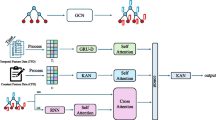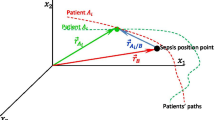Abstract
Sepsis is a life-threatening systemic syndrome characterized by various biological, biochemical, and physiological abnormalities. Due to its high mortality, identifying sepsis patients with high risk of in-hospital death early and accurately will help doctors make optimal clinical decisions and reduce the mortality of sepsis patients. In this paper, we propose a length insensitive TCN-based model to predict sepsis patient’s death risk in the future k hours, which is the first work for sepsis death risk early warning model only based on vital signs time series to our best knowledge. Furthermore, we design residual connections between temporal residual blocks to improve the prediction performance and stability especially on short input sequences. We validate and evaluate our model on two freely-available datasets, i.e., MIMIC-IV and eICU, from which 16,520 and 29,620 patients are selected respectively. The experiment results show that our model outperforms LSTM and other machine learning methods, as it has the highest sensitivity and Youden index in almost all cases. Meanwhile, the Youden index of the TCN-based model only slightly decreases by 0.0233 and 0.0307 when the time range of the input sequence changes from 24 to 4 h for k equal to 6 and 12, respectively.
Graphical abstract








Similar content being viewed by others
Data availability
The databases used in our work, MIMIC-IV and eICU, are freely-available and can be accessed at https://physionet.org/content/mimiciv/0.4 and https://physionet.org/content/eicu-crd/2.0 respectively.
References
Singer M, Deutschman CS, Seymour CW et al (2016) The third international consensus definitions for sepsis and septic shock (Sepsis-3) [J]. Jama 315(8):801–810
Perman SM, Goyal M, Gaieski DF (2012) Initial emergency department diagnosis and management of adult patients with severe sepsis and septic shock[J]. Scand J Trauma Resuscitation Emerg Med 20(1):1–11
Gauer R (2013) Early recognition and management of sepsis in adults: the first six hours[J]. Am Fam Physician 88(1):44–53
Fleischmann C, Scherag A, Adhikari NKJ et al (2016) Assessment of global incidence and mortality of hospital-treated sepsis. Current estimates and limitations[J]. Am J Respir Crit Care Med 193(3):259–272
Rudd KE, Johnson SC, Agesa KM et al (2020) Global, regional, and national sepsis incidence and mortality, 1990–2017: analysis for the Global Burden of Disease Study[J]. Lancet 395(10219):200–211
Esper AM, Martin GS (2009) Extending international sepsis epidemiology: the impact of organ dysfunction[J]. Crit Care 13(1):1–3
Blanco J, Muriel-Bombín A, Sagredo V et al (2008) Incidence, organ dysfunction and mortality in severe sepsis: a Spanish multicentre study[J]. Crit Care 12(6):1–14
Harrison DA, Welch CA, Eddleston JM (2006) The epidemiology of severe sepsis in England, Wales and Northern Ireland, 1996 to 2004: secondary analysis of a high quality clinical database, the ICNARC Case Mix Programme Database[J]. Crit Care 10(2):1–10
Danai P, Martin GS (2005) Epidemiology of sepsis: recent advances[J]. Curr Infect Dis Rep 7(5):329–334
Kaukonen KM, Bailey M, Suzuki S et al (2014) Mortality related to severe sepsis and septic shock among critically ill patients in Australia and New Zealand, 2000-2012[J]. JAMA 311(13):1308–1316
Rangel-Frausto MS, Pittet D, Costigan M et al (1995) The natural history of the systemic inflammatory response syndrome (SIRS): a prospective study[J]. JAMA 273(2):117–123
Goulden R, Hoyle MC, Monis J et al (2018) qSOFA, SIRS and NEWS for predicting inhospital mortality and ICU admission in emergency admissions treated as sepsis[J]. Emerg Med J 35(6):345–349
Khwannimit B, Bhurayanontachai R, Vattanavanit V (2019) Comparison of the accuracy of three early warning scores with SOFA score for predicting mortality in adult sepsis and septic shock patients admitted to intensive care unit[J]. Heart Lung 48(3):240–244
Brink A, Alsma J, Verdonschot RJCG et al (2019) Predicting mortality in patients with suspected sepsis at the Emergency Department; a retrospective cohort study comparing qSOFA, SIRS and National Early Warning Score[J]. PLoS One 14(1):e0211133
Hwang SY, Jo IJ, Lee SU et al (2018) Low accuracy of positive qSOFA criteria for predicting 28-day mortality in critically ill septic patients during the early period after emergency department presentation[J]. Ann Emerg Med 71(1):1–9 e2
Fernando SM, Tran A, Taljaard M et al (2018) Prognostic accuracy of the quick sequential organ failure assessment for mortality in patients with suspected infection: a systematic review and meta-analysis[J]. Ann Intern Med 168(4):266–275
Jaimes F, Leon A, Ascuntar J et al (2016) 1414: Prospective validation of qSOFA in emergency services: a useless bedside clinical score[J]. Crit Care Med 44(12):429
Chen FC, Kung CT, Cheng HH et al (2019) Quick sepsis-related organ failure assessment predicts 72-h mortality in patients with suspected infection[J]. Eur J Emerg Med 26(5):323
Askim Å, Moser F, Gustad LT et al (2017) Poor performance of quick-SOFA (qSOFA) score in predicting severe sepsis and mortality–a prospective study of patients admitted with infection to the emergency department[J]. Scand J Trauma Resuscitation Emerg Med 25(1):1–9
Taylor RA, Pare JR, Venkatesh AK et al (2016) Prediction of in-hospital mortality in emergency department patients with sepsis: a local big data–driven, machine learning approach[J]. Acad Emerg Med 23(3):269–278
Khojandi A, Tansakul V, Li X et al (2018) Prediction of sepsis and in-hospital mortality using electronic health records[J]. Methods Inf Med 57(04):185–193
Rodríguez A, Mendoza D, Ascuntar J et al (2020) Supervised classification techniques for prediction of mortality in adult patients with sepsis[J]. Am J Emerg Med 45:392–397
Perng JW, Kao IH, Kung CT et al (2019) Mortality prediction of septic patients in the emergency department based on machine learning[J]. J Clin Med 8(11):1906
Lea C, Flynn M D, Vidal R, et al. (2017) Temporal convolutional networks for action segmentation and detection[C]. proceedings of the IEEE Conference on Computer Vision and Pattern Recognition. 156-165.
Bai S, Kolter J Z, Koltun V. (2018) Convolutional Sequence Modeling Revisited. International Conference on Learning Representations (ICLR). Workshop.
Johnson A et al (2020) "MIMIC-IV" (version 0.4). PhysioNet. https://doi.org/10.13026/a3wn-hq05
Johnson AEW, Pollard TJ, Shen L et al (2016) MIMIC-III, a freely accessible critical care database[J]. Sci Data 3(1):1–9
Johnson AEW, Aboab J, Raffa JD et al (2018) A comparative analysis of sepsis identification methods in an electronic database[J]. Crit Care Med 46(4):494
Pollard TJ, Johnson AEW, Raffa JD et al (2018) The eICU Collaborative Research Database, a freely available multi-center database for critical care research[J]. Sci Data 5(1):1–13
Hochreiter S, Schmidhuber J (1997) Long short-term memory[J]. Neural Comput 9(8):1735–1780
Chen T, Guestrin C. (2016) Xgboost: A scalable tree boosting system[C]. Proceedings of the 22nd ACM SIGKDD International Conference on Knowledge Discovery and Data Mining. ACM, 785-794.
Funding
This work is supported partially by China NSFC under Grant 61672309.
Author information
Authors and Affiliations
Contributions
Jingming Liu and Wei Guo designed the experiments and provided the clinical expertise and context. Minghui Gong and Chunping Li pre-processed the data and implemented the warning model and experiment. Ruolin Wang contributed to analyses of the data. Zheng Chen provided the clinical expertise and discussion, and revised the paper further.
Corresponding authors
Ethics declarations
Ethical approval and consent to participate
Before we gained access to the MIMIC-IV database, we had passed CITI's ethics test (Record ID: 33389955).
Competing interests
The authors declare no competing interests.
Additional information
Publisher’s note
Springer Nature remains neutral with regard to jurisdictional claims in published maps and institutional affiliations.
Rights and permissions
About this article
Cite this article
Gong, M., Liu, J., Li, C. et al. Early warning model for death of sepsis via length insensitive temporal convolutional network. Med Biol Eng Comput 60, 875–885 (2022). https://doi.org/10.1007/s11517-022-02521-3
Received:
Accepted:
Published:
Issue Date:
DOI: https://doi.org/10.1007/s11517-022-02521-3




